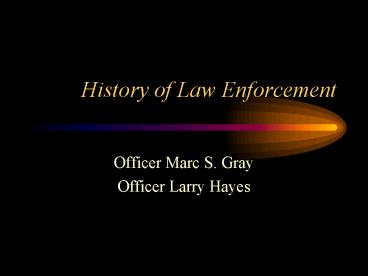History of Law Enforcement - PowerPoint PPT Presentation
1 / 19
Title:
History of Law Enforcement
Description:
The top law enforcement official was called a Shire Reeve. ... The Shire Reeve was sometimes assisted by constables on the local level to apprehend criminals. ... – PowerPoint PPT presentation
Number of Views:6092
Avg rating:3.0/5.0
Title: History of Law Enforcement
1
History of Law Enforcement
- Officer Marc S. Gray
- Officer Larry Hayes
2
Objectives
- Identify the role of Police in Society.
- Discuss the Origins of Modern Law Enforcement.
- Describe the development of municipal and county
law enforcement agencies. - Trace the development of state police
- Explain the development of the federal system of
law enforcement.
3
The First Recorded Police Organization
- Occurred in Egypt under Pharaoh Hur Moheb, in
approximately 1340 B.C. - Hur Moheb established a river security force to
ensure navigational safety on the Nile. - They prevented piracy, guarded commerce, and
searched suspect ships.
4
Police
- The word Police is a derivative of the Greek word
Politeria. - It refers to the portion of government that has
to do with the protection of life and property,
the preservation of public peace and order, and
the prevention and suppression of crime.
5
Romes influence on Law Enforcement
- During the reign of Augustus Caesar the police
became a special unit of the Roman government. - Had Various Grades of Officers.
- Romes population was approximately 750,000.
- Police Force was an estimated 7,000 strong, and
divided into seven divisions.
6
Romes influence on Law Enforcement
- Caesar divided Rome into 14 districts.
- Each had a commanding Officer and 500 officers.
- These districts represent the first police
precincts, a system still used today in large
metropolitan areas.
7
What does this tell us?
- Every society has required some form of police
services. - They established the maintenance of order, the
enforcement of law, and the prevention of crime
as police functions from early human history.
8
ENGLISH ROOTS
- American law enforcement concepts originated in
England. - In approximately 900 A.D. in early medieval
England, law enforcement became the
responsibility of the citizens, - Crime victims would seek justice in the form of
retribution or revenge.
9
ENGLISH ROOTS
- After the Norman Conquest in 1066, King William
(the Conqueror) instituted a form of policing
called the frankpledge system. - In this system, every male over 12 was required
to watch over a group of ten families, called a
tithing. - Members were sworn to apprehend, and bring before
the court, those within their tithing who
committed a crime.
10
ENGLISH ROOTS
- Ten Tithings were grouped together to from one
hundred families, these were called Shires. - The top law enforcement official was called a
Shire Reeve. - This is where the term Sheriff comes from.
- The Shire Reeve was sometimes assisted by
constables on the local level to apprehend
criminals.
11
ENGLISH ROOTS
- The Statue of Winchester was passed in 1285,
establishing the constable (night-watch) system
of protection. - One man from each parish was selected as
constable. - Constables drafted citizens, watchmen, who
guarded the city at night. - The watchmen were not paid, and often were not
doing their job.
12
ENGLISH ROOTS
- In 1326, the Shire Reeve was replaced by the
Justice of The Peace. - The Justice of the Police and the Constables
supervised law enforcement activities. - These aspects carried over until the mid 1700s.
13
ENGLISH ROOTS
- In the mid 1700s when military was used for
crime control, law enforcement was ineffective in
London, England. - Henry Fielding, a London magistrate, put together
a group of eight paid law enforcement agents to
investigate crime in the entertainment district
of London.
14
ENGLISH ROOTS
- They were called The Bow Street Runners
- This were basically what today is a Criminal
Investigative Division (CID). - His ideas paved the way for a more efficient and
professional response to crime and apprehension
of criminals.
15
ENGLISH ROOTS
- Sir Robert Peel
- Father of Modern
- Day Policing
- 1788-1850
16
ENGLISH ROOTS
- In 1829, the English Parliament, led by Sir
Robert Peel mandated publicly funded police
forces. - Under the Metropolitan Police Act, a 1,000
member uniformed police force was created. - They were known as bobbies or Peelers.
17
ENGLISH ROOTSSir Robert Peel
- The London Police was structured according to
military rank. - The police forces main function was to prevent
crime without force by preventative policing.
18
Sir Robert Peels12 Principals of Policing
- The Police must be stable, efficient, and
organized along military lines. - The police must be under government control.
- The absence of crime will best prove efficiency
of police - The distribution of crime news is essential.
- The deployment of police strength by both time
and area is essential. - No quality is more indispensable to a policeman
than a prefect command of temper a quiet,
determined manner has more effect than violent
action.
19
Sir Robert Peels12 Principals of Policing
- Good appearance commands respect.
- The securing and training of proper persons is at
the root of efficiency. - Public security demands that every police officer
be given a number
- Police headquarters should be centrally located
and easily accessible to the people. - Policemen should be hired on a probationary
basis. - Police records are necessary to the correct
distribution of police strength.


















![⚡[PDF]✔ The Pope and Mussolini: The Secret History of Pius XI and the Rise of Fascism PowerPoint PPT Presentation](https://s3.amazonaws.com/images.powershow.com/10048394.th0.jpg?_=20240605099)












